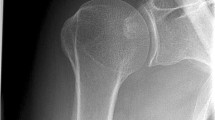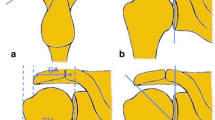Abstract
Purpose
To re-evaluate the relationship between os acromiale and rotator cuff tears.
Methods
We retrospectively analyzed 84 magnetic resonance imaging studies of the shoulder. Forty-two subjects with os acromiale (n = 42; 32 men and ten women, age 25–81 years, mean 47.6 years) were compared with age- and gender-matched subjects with no evidence of os acromiale (controls). Arthroscopy data were available in 19 os acromiale and 12 control subjects. Statistical analyses were performed to determine differences between groups regarding rotator cuff tears affecting the supraspinatus and infraspinatus tendons detected by magnetic resonance imaging and arthroscopy. Analysis of os acromiale type, ossicle synchondrosis edema, acromioclavicular joint degenerative changes and step-off deformity at the synchondrosis were tabulated.
Results
No statistically significant difference between the os acromiale and control groups was noted, either on magnetic resonance imaging or arthroscopy, with regard to tears of the supraspinatus (P = 1.000 and 0.981, respectively) and infraspinatus (P = 1.000 and 0.667, respectively) tendons. There was a statistically significant increased number of supraspinatus (P = 0.007) and infraspinatus (P = 0.03) tears in a comparison of subjects with os acromiale and step-off deformity (10/42) vs os acromiale without step-off deformity (32/42).
Conclusion
The presence of os acromiale may not significantly predispose to supraspinatus and infraspinatus tendon tears. However, subjects with step-off deformity of an os acromiale are at greater risk of rotator cuff tears than are similar subjects without such deformity.


Similar content being viewed by others
References
Sammarco VJ. Os acromiale: frequency, anatomy, and clinical implications. J Bone Joint Surg Am 2000; 82: 394–400.
Park JG, Lee JK, Phelps CT. Os acromiale associated with rotator cuff impingement: MR imaging of the shoulder. Radiology 1994; 193: 255–257.
Fery A, Sommelet J. Os acromiale: significance-diagnosis-pathology. Apropos of 28 cases including 2 with fracture separation. Rev Chir Orthop Reparatrice Appar Mot 1988; 74: 160–172.
Grasso A. The incidence and role of the os acromiale in the acromiohumeral impingement syndrome. Radiol Med (Torino) 1992; 84: 567–570.
Hutchinson MR, Veenstra MA. Arthroscopic decompression of shoulder impingement secondary to os acromiale. Arthroscopy 1993; 9: 28–32.
Mudge MK, Wood VE, Frykman GK. Rotator cuff tears associated with os acromiale. J Bone Joint Surg Am 1984; 66: 427–429.
Nicholson GP, Goodman DA, Flatow EL, Bigliani LU. The acromion: morphologic condition and age-related changes. A study of 420 scapulas. J Shoulder Elbow Surg 1996; 5: 1–11.
Swain RA, Wilson FD, Harsha DM. The os acromiale: another cause of impingement. Med Sci Sports Exerc 1996; 28: 1459–1462.
Warner JJ, Beim GM, Higgins L. The treatment of symptomatic os acromiale. J Bone Joint Surg Am 1998; 80: 1320–1326.
Barbiera F, Bellissima G, Iovane A, De Maria M. OS acromiale producing rotator cuff impingement and rupture. A case report. Radiol Med (Torino). 2002; 104: 359–362.
Boehm TD, Matzer M, Brazda D, Gohlke FE. Os acromiale associated with tear of the rotator cuff treated operatively. Review of 33 patients. J Bone Joint Surg Br 2003; 85: 545–549.
Lee SI, Chew FS. 1998 ARRS Executive Council Award. Radiology in the emergency department: technique for quantitative description of use and results. American Roentgen Ray Society. AJR Am J Roentgenol 1998; 171: 559–564.
Thomas BJ, Ouellette H, Halpern EF, Rosenthal DI. Automated computer-assisted categorization of radiology reports. AJR Am J Roentgenol 2005; 184: 687–690.
Fleiss J. Statistical methods for rates and proportions. New York, NY: Wiley, 1981.
Neer CS 2nd. Impingement lesions. Clin Orthop Relat Res 1983; 173: 70–77.
Jerosch J, Steinbeck J, Strauss JM, Schneider T. Arthroscopic subacromial decompression-indications in os acromiale? Unfallchirurg 1994; 97: 69–73.
Boehm TD, Rolf O, Martetschlaeger F, Kenn W, Gohlke F. Rotator cuff tears associated with os acromiale. Acta Orthop 2005; 76: 241–244.
Uri DS, Kneeland JB, Herzog R. Os acromiale: evaluation of markers for identification on sagittal and coronal oblique MR images. Skeletal Radiol 1997; 26: 31–34.
Edelson JG, Zuckerman J, Hershkovitz I. Os acromiale: anatomy and surgical implications. J Bone Joint Surg Br 1993; 75: 551–555.
Author information
Authors and Affiliations
Corresponding author
Rights and permissions
About this article
Cite this article
Ouellette, H., Thomas, B.J., Kassarjian, A. et al. Re-examining the association of os acromiale with supraspinatus and infraspinatus tears. Skeletal Radiol 36, 835–839 (2007). https://doi.org/10.1007/s00256-007-0305-7
Received:
Revised:
Accepted:
Published:
Issue Date:
DOI: https://doi.org/10.1007/s00256-007-0305-7




